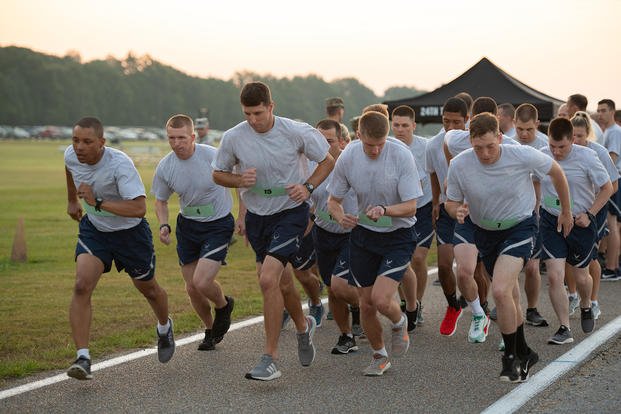It must be springtime. It seems that this week, the email box was loaded with quick fixes for the physical fitness test (PFT) in a few weeks or requests for getting PFT failures to pass the semiannual fitness assessment.
Here are several issues people have with fitness tests and ways to surpass these pitfalls that lead to failure.
Nauseated During the Test
Nausea or actually throwing up during a fitness test (or workout) often is caused by a lack of proper fuel in your body. Getting lightheaded can be a symptom of low blood sugar, which is usually caused by having not eaten anything in several hours. Consume some good carbs, such as fruits, juice or Gatorade (in a crunch), before the test. Simply sipping something will help you not only perform better but also avoid getting lightheaded, leading to nausea.
Another nausea-causing issue is motion sickness. During the sit-ups or push-ups, even if you have any allergy or head-cold symptoms, the movement of your head can cause nausea during your test. You can avoid that the same way sailors avoid getting seasick -- look at something stable. On the ocean, it is the horizon. During a fitness test, it can be a spot on the wall or ceiling. Do not close your eyes or let your eyes scan the room while moving.
And yet another reason why you may be nauseated is PFT Anxiety.

Cannot Pass the Run
You have to practice running to be fit enough to pass a fitness test run of 1.5, two or three miles. You cannot just wish this to go away. There is no need to run every day, but at least every other day is required to build your legs and lungs for this event.
Two weeks before your test is not the time to start training. You should make some form of cardio a regular event in your life, with non-impact cardio accomplished on the days between running. You do not need to run a marathon, but you do need to be comfortable running the distance you are tested as a normal workout. Try to fit five days of cardio into your seven-day week:
|
Day 1 |
Day 2 |
Day 3 |
Day 4 |
Day 5 |
|
Run your test distance and build up to 2x your test distance over time. |
Non-impact cardio: bike, elliptical, row, swim, stair stepper ... 20- to 30-minute steady pace |
Run intervals of goal pace running: Try the distance of your test broken up into quarter miles at your goal pace.* |
Non-impact cardio: bike, elliptical, row, swim, stair stepper ... 20-30 minutes of intervals, with one minute fast/one minute slow |
Run your test distance, plus 2-3 quarter-miles or half-miles at faster than goal pace. |
*For example: If you want to run 1.5 miles in 12 minutes, you need to run a two-minute, quarter-mile split.
Recovering from Injury Shortly Before a Test
If you are cleared hot and ready to roll with your training, here is a plan that can help you do it in two weeks. I do not recommend only working out for two weeks before every fitness test; eventually, it will catch up to you and you will fail or injure yourself (again).
What Is a Good Remedial Plan for PFT Failures?
Well, it depends. Most failures are a few seconds or reps short of a passing grade. That usually can be fixed with a few more tests and some technique assistance for either running, sit-ups or push-ups.
Running Technique is important, but your pace can be the biggest issue. Most people start out way too fast the first quarter mile, only to slow down each quarter mile. Find your pace.
Sit-ups Technique and Tips can help you go from failing one day and passing the next.
Push-up Hand and Body Placement is the biggest reason why people fail push-ups. Well, also not practicing push-ups is the major culprit.
Teaching these skills and having members practice them during their group workouts will assist with getting the group over the top.
The toughest group is the deconditioned group to pass the PFT. This is the group that, for many reasons, cannot exercise. You have to treat this group like a beginner to fitness. If you do a command PT evolution with them, it could break them, and they will remain injured and unable to take the test, period.
I treat all beginners the same. Build a foundation of core strength and flexibility. Focus on the basics with calisthenics, machine weights or dumbbells to build strength. If overweight, too, have them do more non-impact aerobic activity to build cardio stamina and lose weight safely.
I hope this helped the many levels you have to approach remedial PT programming. One size will not fit all, so be smart and remind them that one day, their fitness level may be the difference of life and death for themselves, a teammate or a family member. Yes, it is that serious.
Stew Smith is a former Navy SEAL and fitness author certified as a Strength and Conditioning Specialist (CSCS) with the National Strength and Conditioning Association. Visit his Fitness eBook store if you're looking to start a workout program to create a healthy lifestyle. Send your fitness questions to stew@stewsmith.com.
Want to Learn More About Military Life?
Whether you're thinking of joining the military, looking for fitness and basic training tips, or keeping up with military life and benefits, Military.com has you covered. Subscribe to Military.com to have military news, updates and resources delivered directly to your inbox.



















